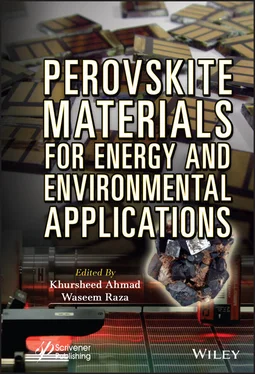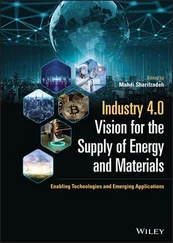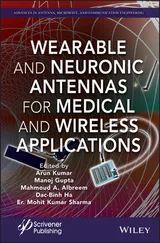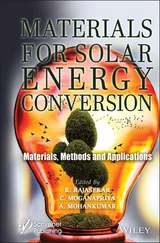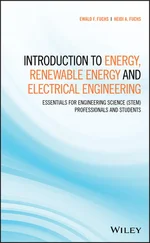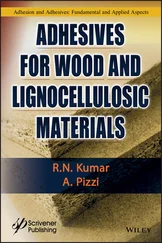Perovskite Materials for Energy and Environmental Applications
Здесь есть возможность читать онлайн «Perovskite Materials for Energy and Environmental Applications» — ознакомительный отрывок электронной книги совершенно бесплатно, а после прочтения отрывка купить полную версию. В некоторых случаях можно слушать аудио, скачать через торрент в формате fb2 и присутствует краткое содержание. Жанр: unrecognised, на английском языке. Описание произведения, (предисловие) а так же отзывы посетителей доступны на портале библиотеки ЛибКат.
- Название:Perovskite Materials for Energy and Environmental Applications
- Автор:
- Жанр:
- Год:неизвестен
- ISBN:нет данных
- Рейтинг книги:5 / 5. Голосов: 1
-
Избранное:Добавить в избранное
- Отзывы:
-
Ваша оценка:
- 100
- 1
- 2
- 3
- 4
- 5
Perovskite Materials for Energy and Environmental Applications: краткое содержание, описание и аннотация
Предлагаем к чтению аннотацию, описание, краткое содержание или предисловие (зависит от того, что написал сам автор книги «Perovskite Materials for Energy and Environmental Applications»). Если вы не нашли необходимую информацию о книге — напишите в комментариях, мы постараемся отыскать её.
The book provides a state-of-the-art summary and discussion about the recent progress in the development and engineering of perovskite solar cells materials along with the future directions it might take.
Audience
Perovskite Materials for Energy and Environmental Applications — читать онлайн ознакомительный отрывок
Ниже представлен текст книги, разбитый по страницам. Система сохранения места последней прочитанной страницы, позволяет с удобством читать онлайн бесплатно книгу «Perovskite Materials for Energy and Environmental Applications», без необходимости каждый раз заново искать на чём Вы остановились. Поставьте закладку, и сможете в любой момент перейти на страницу, на которой закончили чтение.
Интервал:
Закладка:
28. Decock, K., Khelifi, S., Burgelman, M., Modelling multivalent defects in thin film solar cells. Thin Solid Films , 519, 21, 7481–7484, 2011.
29. Burgelman, M. and Marlein, J., Analysis of graded band gap solar cells with SCAPS, in: Proceedings of the 23rd European Photovoltaic Solar Energy Conference , Valencia, pp. 2151–2155, 2008, September.
30. Verschraegen, J. and Burgelman, M., Numerical modeling of intra-band tunneling for heterojunction solar cells in SCAPS. Thin Solid Films , 515, 15, 6276–6279, 2007.
31. Degrave, S., Burgelman, M., Nollet, P., Modelling of polycrystalline thin film solar cells: new features in SCAPS version 2.3, in: 3rd World Conference on Photovoltaic Energy Conversion, Proceedings of 2003 , vol. 1, IEEE, pp. 487– 490, 2003, May.
32. Niemegeers, A. and Burgelman, M., Numerical modelling of ac-characteristics of CdTe and CIS solar cells, in: Conference Record of the Twenty Fifth IEEE Photovoltaic Specialists Conference-1996 , IEEE, pp. 901–904, 1996, May.
33. Press, W.H., Teukolsky, S.A., Flannery, B.P., Vetterling, W.T., Numerical recipes in Fortran 77: of Fortran numerical recipes: the art of scientific computing , vol. 1, Cambridge university press, Cambridge, 1992.
34. Verschraegen, J., Khelifi, S., Burgelman, M., Belghachi, A., Numerical modeling of the impurity photovoltaic effect (IPV) in SCAPS, in: 21st European Photovoltaic Solar Energy Conference , vol. 396, WIP, 2006, September.
35. Khelifi, S., Burgelman, M., Verschraegen, J., Belghachi, A., Impurity photovoltaic effect in GaAs solar cell with two deep impurity levels. Sol. Energy Mater. Sol. Cells , 92, 12, 1559–1565, 2008.
36. Khelifi, S., Verschraegen, J., Burgelman, M., Belghachi, A., Numerical simulation of the impurity photovoltaic effect in silicon solar cells. Renew. Energy , 33, 2, 293–298, 2008.
37. Decock, K., Zabierowski, P., Burgelman, M., Modeling metastabilities in chalcopyrite-based thin film solar cells. J. Appl. Phys. , 111, 4, 043703, 2012.
38. Burgelman, M., Decock, K., Khelifi, S., Abass, A., Advanced electrical simulation of thin film solar cells. Thin Solid Films , 535, 296–301, 2013.
39. Niemegeers, A., Gillis, S., Burgelman, M., A user program for realistic simulation of polycrystalline heterojunction solar cells: SCAPS-1D. Proceedings of the 2nd World Conference on Photovoltaic Energy Conversion , JRC, European Commission, juli, pp. 672–675, 1998.
40. Pauwels, H.J. and Vanhoutte, G., The influence of interface state and energy barriers on the efficiency of heterojunction solar cells. J. Phys. D: Appl. Phys. , 11, 5, 649, 1978.
41. Verschraegen, J., Karakterisering en modellering met SCAPS van de CISCuT dunne-filmzonnecel, dissertation Universiteit Gent. Faculteit Ingenieurswetenschappen, 2006
42. Selberherr, S., Analysis and simulation of semiconductor devices, in: Springer Science & Business Media , 1984.
43. Marlein, J. and Burgelman, M., Empirical JV modelling of CIGS solar cells. In Proceedings of NUMOS (Int. Workshop on Numerical Modelling of Thin Film Solar Cells, Gent (B), 28-30 March 2007). 227-233, 227–233, 20072007. AU: Please provide journal title.
44. Walter, T., Herberholz, R., Müller, C., Schock, H.W., Determination of defect distributions from admittance measurements and application to Cu (In, Ga) Se2 based heterojunctions. J. Appl. Phys. , 80, 8, 4411–4420, 1996.
45. Decock, K., Khelifi, S., Buecheler, S., Pianezzi, F., Tiwari, A.N., Burgelman, M., Defect distributions in thin film solar cells deduced from admittance measurements under different bias voltages. J. Appl. Phys. , 110, 6, 063722, 2011.
46. Sharma, B., Mathur, A.S., Rajput, V.K., Singh, I.K., Singh, B.P., Device modeling of non-fullerene organic solar cell by incorporating CuSCN as a hole transport layer using SCAPS. Optik , 251, 168457, 2022.
47. Mathur, A.S., Upadhyay, S., Singh, P.P., Sharma, B., Arora, P., Rajput, V.K., Kumar, P., Singh, D., Singh, B.P., Role of defect density in absorber layer of ternary chalcogenide Cu2SnS3 solar cell. Optic. Mater. , 119, 111314, 2021.
48. Mathur, A.S. and Singh, B.P., Study of effect of defects on CdS/CdTe heterojunction solar cell. Optik , 212, 164717, 2020.
49. Mathur, A.S., Dubey, S., Singh, B.P., Study of role of different defects on the performance of CZTSe solar cells using SCAPS. Optik , 206, 163245, 2020.
1 * Corresponding author: arpitswarupmathur@gmail.com
2
Fundamentals of Perovskite Solar Cells
Neha Patni*, Rokadia Zulfiqar and Krishna Patel
Chemical Engineering Department, Institute of Technology, Nirma University, Ahmedabad, Gujarat, India
Abstract
Perovskite solar cell (PSC) is a type of third-generation hybrid solar cell based on organic-inorganic metal halide material, having the molecular formula of the type ABX 3. High efficiency, flexibility, cell architecture, and low-cost production of the PSC have caught the attention of researchers and technologists in the field. There is a tremendous growth of efficiency in a short period, i.e., 3.8% in 2009 to nearly 25% in 2020. This chapter discusses the fundamental principle used in PSCs. Its structure, various layers of the cell, and their significance will be conferred. The chapter will also cover the working of the solar cell and discuss the various parameters on which the efficiency of the solar cell will depend. Fundamental properties of PSCs will be examined like high optical absorption, tunable bandgap, high open-circuit voltage, which is one of the most promising aspects of the perovskite technology that the cells can generate under full sun illumination with low loss‐ in‐potential. In the end, drawbacks of PSCs, like stability and toxicity, will be analyzed and its reasons will be examined in brief.
Keywords:Perovskite, solar cell, open-circuit voltage, power conversion efficiency
2.1 Introduction
Our planet’s energy consumption has increased because of rapid industrialization and urbanization. To meet this energy requirement, the use of fossil fuels like coal, natural gas, and oil has increased tremendously. As a result, there is depletion in fossil fuel. Fossil fuels have advantages, like production of enormous energy, easy availability, cost effectiveness, easy transportation, but has several environmental issues. The use of fossil fuel is the main source of local air pollution, escalating carbon emissions, which leads to increase in the greenhouse gases, and their combustion makes the atmosphere more acidic. Moreover, fossil fuel is a nonrenewable source of energy which means in near future, these resources are going to vanish. As per the review of literature, from last six years the oil is left for around fifty years, natural gas for around fifty two years and coal for around one hundred ten years. The solution to this energy crisis is the renewable sources of energy like solar energy, hydrogen energy, wind energy, tidal energy, ocean thermal energy, biogas, biofuels, and geothermal energy.
The flow of research in renewable energy technology has increased tremendously. Out of all the sources of renewable sources of energy, solar energy is the most encouraging and applied approach. Solar energy comes with long-time warranty and low maintenance costs, environment friendly, and easy to adapt. Solar energy can lead us to sustainable development.
Photovoltaic cells are classified into first, second, and third generations as depicted in Figure 2.1. First-generation cells are silicon-based crystalline cells, which are commercially used. Si-based crystalline cells are widely applied cells because of their high stability and high efficiency (nearly 45%). Second-generation cells are thin film–based cells. Third-generation cells are new emerged technology-based cells. Perovskite is the third generation cell. An ideal solar cell should be highly efficient, stable, less costly, simple to fabricate, and environment friendly. None of the existing cells is ideal. Si-based cells have a high cost of production and complex fabrication process. Cadmium tellurium (CdTe) solar cell and copper indium gallium silicon (CIGS) solar cell are second-generation cells that have achieved high efficiency but have some disadvantages. Cadmium tellurium faces the problem of a low abundance of tellurium and toxicity of cadmium, whereas CIGS has the main problem of scarcity of indium in its industrial applications. These limitations lead to the emergence of the third-generation solar cells.
Читать дальшеИнтервал:
Закладка:
Похожие книги на «Perovskite Materials for Energy and Environmental Applications»
Представляем Вашему вниманию похожие книги на «Perovskite Materials for Energy and Environmental Applications» списком для выбора. Мы отобрали схожую по названию и смыслу литературу в надежде предоставить читателям больше вариантов отыскать новые, интересные, ещё непрочитанные произведения.
Обсуждение, отзывы о книге «Perovskite Materials for Energy and Environmental Applications» и просто собственные мнения читателей. Оставьте ваши комментарии, напишите, что Вы думаете о произведении, его смысле или главных героях. Укажите что конкретно понравилось, а что нет, и почему Вы так считаете.
